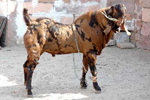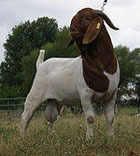Jamunapari Goat
Price 350 INR/ Kilograms
Jamunapari Goat Specification
- Product Type
- Jamunapari Goat
- Commercial Uses
- Dairy
- Color
- white or light yellowish tan
- Gender
- Female
Jamunapari Goat Trade Information
- Minimum Order Quantity
- 5 Kilograms
- Payment Terms
- Cash in Advance (CID), Cash Advance (CA)
- Supply Ability
- 10000 Kilograms Per Week
- Delivery Time
- 2-7 Days
- Main Export Market(s)
- Western Europe, Australia, Eastern Europe, Central America, Middle East, South America, Asia, North America, Africa
- Main Domestic Market
- All India
About Jamunapari Goat
Conformation There is a great variation in coat color but they are generally white or light yellowish tan with light brown spots on the neck and face, and occasionally patches of tan or black are found on the body. The typical character of the breed is a highly convex nose line with a tuft of hair known as Roman nose or parrot mouth appearance. The ears are very long, flat and drooping. Both sexes are horned with short and thin tail. A thick growth of hair is present on the buttocks, known as feathers. The breed has well developed udder round in shape with large conical teats. Performance Milk: Average daily yield varies from 1.5 to 2.0 kg per day with a total lactation yield of about 200 kg. Kidding: Usually doe kids once a year, giving birth to single in 57% while twins in 43% cases, They kid once a year.FAQs of Jamunapari Goat:
Q: What are the primary uses of the Jamunapari Goat?
A: The Jamunapari Goat is primarily used for dairy purposes and can also be used for home and hotel cooking, including fried and roasted preparations.Q: What features make the Jamunapari Goat a beneficial choice?
A: The Jamunapari Goat is effective, highly nutritious, rich in vitamins, and well-suited for commercial and culinary applications.Q: What is the typical color of the Jamunapari Goat?
A: The Jamunapari Goat is generally white or has a light yellowish tan color.Q: What gender classification is available for the Jamunapari Goat?
A: The Jamunapari Goat is specifically categorized as female in this offering.Q: Which parts of the Jamunapari Goat are utilized?
A: The body parts of the Jamunapari Goat are used in its various applications.

Price:
- 50
- 100
- 200
- 250
- 500
- 1000+
More Products in Goat Breeds Category
Sirohi Goat
Price 300 INR / Kilograms
Minimum Order Quantity : 5 Kilograms
Feature : Vitamins, Nutritious
Usage : For Home and Hotels
Part : Body
Cooked Processing Type : Roasted, Steamed, Fried
Boer Goat
Price 315 INR / Kilograms
Minimum Order Quantity : 5 Kilograms
Feature : Effective, Nutritious, Vitamins
Usage : For Home and Hotels
Part : Body
Cooked Processing Type : Roasted, Steamed, Fried
Sojat Goat
Price 350 INR / Kilograms
Minimum Order Quantity : 5 Kilograms
Feature : Effective, Vitamins, Nutritious
Usage : For Home and Hotels
Part : Body
Cooked Processing Type : Roasted, Steamed, Fried
Hyderabadi Goat
Price 355 INR / Kilograms
Minimum Order Quantity : 5 Kilograms
Feature : Vitamins, Nutritious, Effective
Usage : For Home and Hotels
Part : Body
Cooked Processing Type : Roasted, Steamed, Fried




 Send Inquiry
Send Inquiry





